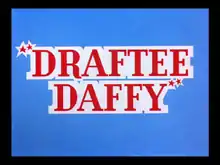Draftee Daffy
Draftee Daffy is a 1945 Warner Bros. Looney Tunes cartoon directed by Bob Clampett.[1] The cartoon was released on January 27, 1945, and stars Daffy Duck.[2]
| Draftee Daffy | |
|---|---|
 Title card | |
| Directed by | Robert Clampett |
| Produced by | Edward Selzer (uncredited) |
| Story by | Lou Lilly |
| Starring | Mel Blanc (uncredited) |
| Music by | Musical Direction: Carl W. Stalling Orchestration: Milt Franklyn (uncredited) |
| Animation by | Rod Scribner Uncredited Animation: Manny Gould Robert McKimson Basil Davidovich Bill Melendez (assistant) A. C. Gamer (effects animation) |
| Layouts by | Thomas McKimson (uncredited) |
| Backgrounds by | Micheal Sasanoff (uncredited) |
| Color process | Technicolor |
Production company | |
| Distributed by | Warner Bros. Pictures The Vitaphone Corporation |
Release date |
|
Running time | 7 minutes |
| Language | English |
Plot
Having read about the U.S. fighting forces pushing the Nazi troops back during World War II ("A smashing frontal attack on the enemy rear?"), Daffy Duck is in a patriotic mood. However, his mood quickly changes to fear when he gets a phone call that "the little man from the draft board" wants to see him. Hiding in his house, Daffy looks out, eventually seeing the little man, who attempts to hand him a telegram (presumably with Daffy's conscription order). Daffy starts whining, and continues to try to outrun the little man, who seems to be everywhere that Daffy happens to be at the moment. Daffy even goes so far as to plant a bomb near the man. Finally, he locks him in a safe, bricks the safe up, puts up a wall over the bricks (chortling: "So long, Dracula!"), runs to the roof and takes off in a rocket.
However, the rocket soon plunges back to earth, causing Daffy to crash-land in Hell without Daffy actually saying the word. Shrugging off this turn, Daffy spots a demon (seen from the rear) and tells him: "Oh well, anyway, I sure put one over on that dope from the draft board!" The demon takes off his mask to reveal he's the man from the draft board, who then replies with a popular catchphrase of the "Richard Q. Peavey" character from The Great Gildersleeve: "Well, now, I wouldn’t say that" (same as what Bugs Bunny says at the end of The Old Grey Hare) and proceeds to chase Daffy into the distance, letter still in hand, at iris out.
Reception
Animation historian Jerry Beck writes that in this film, Clampett "gives Daffy Duck the first nuance to his zany personality — something Chuck Jones would expand upon in later shorts — by making the duck an out-an-out coward. Even funnier, the little man from the draft board is portrayed by a nerdy 4F reject, who personifies government intrusion in our lives."[3]
Availability
- VHS, LaserDisc - Cartoon Moviestars: Bugs & Daffy: The Wartime Cartoons
- LaserDisc - The Golden Age of Looney Tunes, Vol. 2, Side 5: Bob Clampett
- VHS - Looney Tunes: The Collectors Edition Volume 7: Welcome To Wackyland (USA 1995 Turner print)
- DVD - Looney Tunes Golden Collection: Volume 3, Disc Four (with optional audio commentary by Eddie Fitzgerald and John Kricfalusi)
- Blu-ray, DVD - Looney Tunes Platinum Collection: Volume 3, Disc 2
Notes
- Daffy had already been depicted as in fact serving in the armed forces in two earlier cartoons, Daffy - The Commando and Plane Daffy. However, continuity rarely received much attention in cartoons of this period. During this time period, stories were written and structured to fit around gags and jokes without any continuous intent or any relation to the character's past adventures.
- The setup of Daffy and The Little Man from the Draft Board in this cartoon is very similar to that of the wolf and Droopy from the Tex Avery cartoons from rival studio MGM (particularly the Droopy cartoon "Dumb Hounded"), as The Little Man from the Draft Board often pops up everywhere Daffy is, causing the duck to flee to escape from him throughout the picture to avoid getting drafted into the army.
- The Little Man from the Draft Board makes a cameo in the Tiny Toon Adventures episode, "Buster's Directorial Debut" and later in the Animaniacs episode, "Pitter Patter of Little Feet".
- This is the first Looney Tunes short to have the black background with red rings, a color scheme that had previously been used in the 1942–43 season. However, the black background is much smaller than the 1942–43 season.
- This is the final WWII-themed cartoon released by Warner Bros. before the end of the war (discounting war references in later cartoons).
References
- Beck, Jerry; Friedwald, Will (1989). Looney Tunes and Merrie Melodies: A Complete Illustrated Guide to the Warner Bros. Cartoons. Henry Holt and Co. p. 157. ISBN 0-8050-0894-2.
- Lenburg, Jeff (1999). The Encyclopedia of Animated Cartoons. Checkmark Books. pp. 70–72. ISBN 0-8160-3831-7. Retrieved 6 June 2020.
- Beck, Jerry, ed. (2020). The 100 Greatest Looney Tunes Cartoons. Insight Editions. p. 54. ISBN 978-1-64722-137-9.
External links
| Wikiquote has quotations related to: Draftee Daffy |